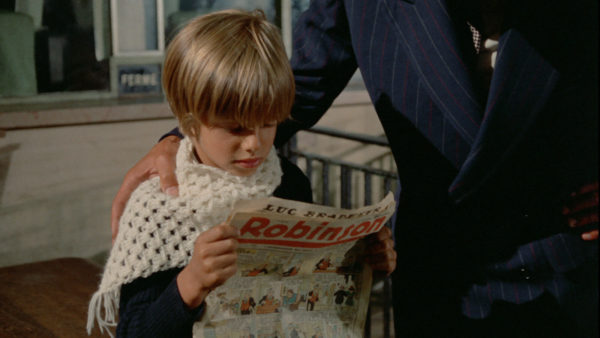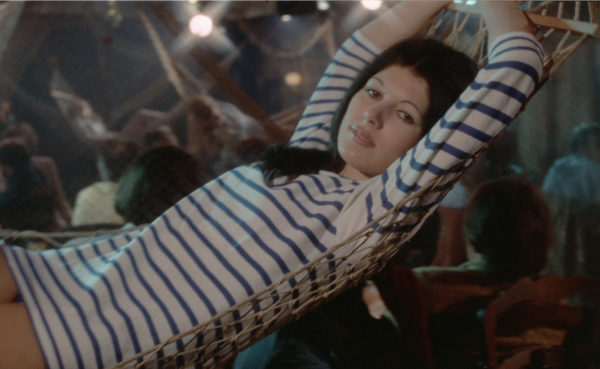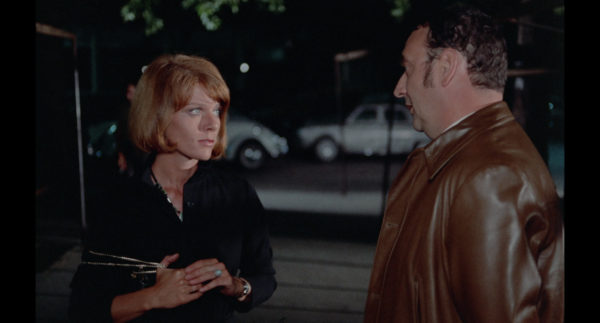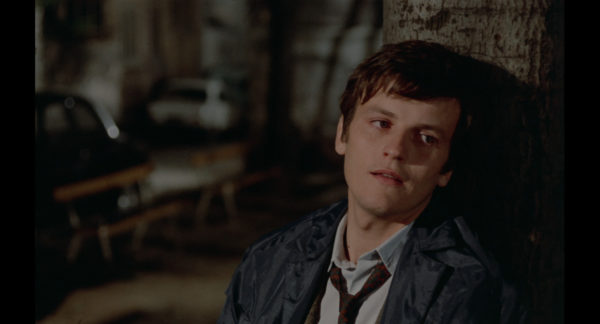
At the offset of The Stranger, Émile, a young boy, smashes his piggy bank and sneaks out of his room so he can buy a comic strip from a newspaper vendor. What he doesn’t realize when he absentmindedly sits on a nearby picnic table is that an older man is following him.
The man proceeds to guide Émile down a deserted street where he uses a crocheted white scarf to strangle an older woman as the boy watches.
This is the opening of Paul Vecchiali’s 1970 French giallo-esque film. The Stranger played at Cannes and had a re-release in France in 2015, but according to Variety, it never played in North America. That’s changing thanks to a 2K restoration by France’s National Centre of Cinematography and Animated Pictures (CNC) and distributor Altered Innocence.
The restoration is rich and vibrant, minus a few scenes that hint that work prints were unsalvageable (a few dark moments and one scene that appears to consist of two takes from different locations). Despite this, however, a queer classic is now available for (re)discovery by a brand new generation of cinephiles.
In true Giallo fashion, The Strangler is an occasionally baffling thriller. Émile grows up into a gorgeous, but disturbed young man (Jacques Perrin) who becomes the titular strangler in his own right. He seeks out lonely, depressed, and even suicidal women (often of a certain age) and gently strangles them with his signature white scarf, which he crochets in his spare time.

Contemporary audiences will undoubtably struggle (at least initially) with the way that characters respond to violence and danger. No one in the film seems particularly worried that they may be murdered, but that’s part of its odd appeal. Ironically, very little of the film is “thrilling” by conventional standards, but that’s because very little of The Strangler works conventionally.
The victims are incredibly fatalistic and French: their beauty is untarnished despite their sad lives, which Émile livens up briefly in the short while before he murders them. Sometimes the victims are barely characters, so the women appear onscreen moments before they are killed. Other times, however, Émile seemingly woos them into accepting death with a prolonged, often intimate discussion.

This is the case with Monique (Jacqueline Danno), a melancholy singer in a sailor-themed nightclub who Émile stops from dying by suicide so that he can kill her. This scenario is repeated with faded actress Hélène (Hélène Surgère), who Émile charms by pretending to be a scarf salesman in a scene that takes on the guise of an elaborate role play or acting challenge.
What makes The Strangler so baffling, however, is not the victims, but rather the detectives. The role is bisected between two characters: Inspector Simon Dangret (Julien Guiomar) and young, but no less fatalistic Anna (Eva Simonet).
Neither character is exactly what they initially appear to be: while they adhere to the tropes of detective and potential victim, both Dangret and Anna spend a majority of their screentime talking about Émile or trying to spend time with him.
Dangret is introduced posing as a therapist on TV who makes a plea for the killer to reach out. Émile reveals himself to Dangret early and the detective responds not by turning him in, but by asking him to delay killing for a few days.

Anna, meanwhile, first seeks out Dangret, and then Émile himself, who has already been circling her. Her unhealthy interest in the killer shifts her status from likely victim to Dangret’s lover and back again, though the young woman appears as eager for death as every other woman in the film.
Adding to the unusual proceedings is the other man who knows Émile’s identity: Le Chacal (Paul Barge). This character follows Émile around so that he can steal the victim’s money and jewelry.
In this fashion, although Anna is certainly in the mix, the majority of the film’s key relationships and actions (stalking, wooing, conversing) happens between men. And while the act of strangling is deeply intimate, Émile seems deeply uninterested in the sexuality of his victims (he ironically admits at one point that he has simply never meet a disaffected man).

Later in the film, as Émile hangs out in a park after dark, he is approached by a male sex worker (Jean-Michel Dhermay). The call boy initially propositions Émile for an exorbitant amount, then threatens him with physical violence. This occurs after Émile has dinner and observes an interaction between two men who may be together (romantically) or simply coded gay.
These side characters inform a queer reading of the film, which is focalized through Émile’s gay coding. Consider: his obsession with older women, his lack of sexual interest in Anna, his homoerotic interactions with his doppelgänger Le Chacal, and his burgeoning friendship/courtship with Dangret.
The intriguing queer undercurrent helps make The Strangler a worthwhile watch. There’s also its jaunty score, its 70s France fashion, and a plethora of sexual characters and sexualities (deviant or otherwise).
This is a restoration worth seeking out for the purposes of (re)discovery and (re)appraisal. 4/5
Other Observations:
- The scene of french women dancing in unison on the tables during Monique number is one of the most vividly memorable sequences I have seen in quite some time. There’s no food or drinks in the whole restaurant so these patrons truly just came for the women in panties and sailor tops lounging about. So French!
The Strangler played Fantastic Fest 2023 and will be distributed by Altered Innocence in the fall.